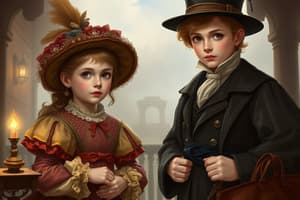Podcast
Questions and Answers
During which period did Queen Victoria reign?
During which period did Queen Victoria reign?
- 1900s
- 1700s
- 1800s (correct)
- 1600s
What significant changes marked the Victorian era?
What significant changes marked the Victorian era?
- Technological advancements and space exploration
- Artistic innovations and cultural revival
- Agricultural improvements and educational reforms
- Political reforms and social restructuring (correct)
How did Queen Victoria's personal life influence her reign?
How did Queen Victoria's personal life influence her reign?
- She actively engaged in diplomatic relations
- She focused on expanding the British Empire
- She withdrew from public life after her husband's death (correct)
- She embraced a lavish lifestyle
What major historical event coincided with the beginning of Victoria's reign?
What major historical event coincided with the beginning of Victoria's reign?
Which aspect of society experienced significant growth during the Victorian era?
Which aspect of society experienced significant growth during the Victorian era?
What were the key developments during the Victorian era?
What were the key developments during the Victorian era?
Who were part of the upper class during the Victorian era?
Who were part of the upper class during the Victorian era?
What characterized the lifestyle of the working class during the Victorian era?
What characterized the lifestyle of the working class during the Victorian era?
Which social issue did British literature from the Victorian era highlight?
Which social issue did British literature from the Victorian era highlight?
Who was the monarch during the Victorian era?
Who was the monarch during the Victorian era?
Flashcards are hidden until you start studying
Study Notes
Victorian Age
The term "Victorian era" refers to the period of British history spanning from 1837 when Queen Victoria ascended to the throne until her death in 1901. This era marked significant changes in literature, social structure, and industrialization, which heavily influenced both England and the world.
Queen Victoria
Queen Victoria was born on May 24, 1819, in London. Her reign lasted for 63 years, making it the longest in British history. During her time, she oversaw major transformations in the United Kingdom, particularly in its political and economic spheres.
Reign and Impact
Victoria's reign began during the Industrial Revolution, which saw tremendous advancements in various sectors, such as steel production and textile manufacturing. Her reign was also characterized by significant political changes, including the establishment of the modern system of government, the development of the parliamentary democracy, and the extension of the franchise to include more people.
Family and Legacy
Queen Victoria married Prince Albert of Saxe-Coburg and Gotha in 1840, and together they had nine children. Her reign was marked by a deep sense of personal loss after Albert's death in 1861, which led her to enter a period of deep mourning. Despite this, Victoria continued to play an active role in the political life of the country until her death in 1901.
Industrial Revolution
The Victorian era was a period of significant industrial growth in the United Kingdom. The Industrial Revolution, which began in the late 18th century, continued to evolve during this period.
Key Developments
Key developments during the Victorian era included the expansion of the railway network, the introduction of new technologies in textile manufacturing, and the growth of coal mining. The expansion of industries led to the creation of many jobs, which contributed to the growth of the middle class.
Impact on Society
The Industrial Revolution significantly affected the social structure of the United Kingdom. The expansion of industries led to the growth of towns and cities, which attracted a large number of people from rural areas in search of work. This led to the formation of a large urban working class and contributed to the development of the trade union movement.
Social Class
The Victorian era was characterized by a rigid social structure, with three main classes: the upper class, the middle class, and the working class.
Upper Class
The upper class, also known as the aristocracy, was made up of the royal family, the nobility, and the gentry. They held a significant amount of power and wealth, and their lifestyle was characterized by leisure and extravagance.
Middle Class
The middle class, also known as the bourgeoisie, was made up of business owners, professionals, and civil servants. They were a growing force in British society during the Victorian era, and their lifestyle was characterized by a desire for social mobility and material comfort.
Working Class
The working class, also known as the proletariat, was made up of manual laborers and factory workers. Their lifestyle was characterized by hard work, long hours, and low wages.
Literature
The Victorian era was also a period of significant growth in British literature. Some notable works from this period include:
- Charles Dickens' "A Tale of Two Cities"
- Charles Dickens' "Great Expectations"
- Herman Melville's "Moby Dick"
- Emily Bronte's "Wuthering Heights"
- Oscar Wilde's "The Importance of Being Earnest"
These works, among others, highlighted the social issues of the time, such as poverty, inequality, and the struggle for social justice.
In conclusion, the Victorian era was a time of significant change and development in the United Kingdom. It was marked by the reign of Queen Victoria, the Industrial Revolution, the development of a rigid social structure, and the growth of British literature. These factors, among others, contributed to the distinctive character of this period and continue to influence British society today.
Studying That Suits You
Use AI to generate personalized quizzes and flashcards to suit your learning preferences.




